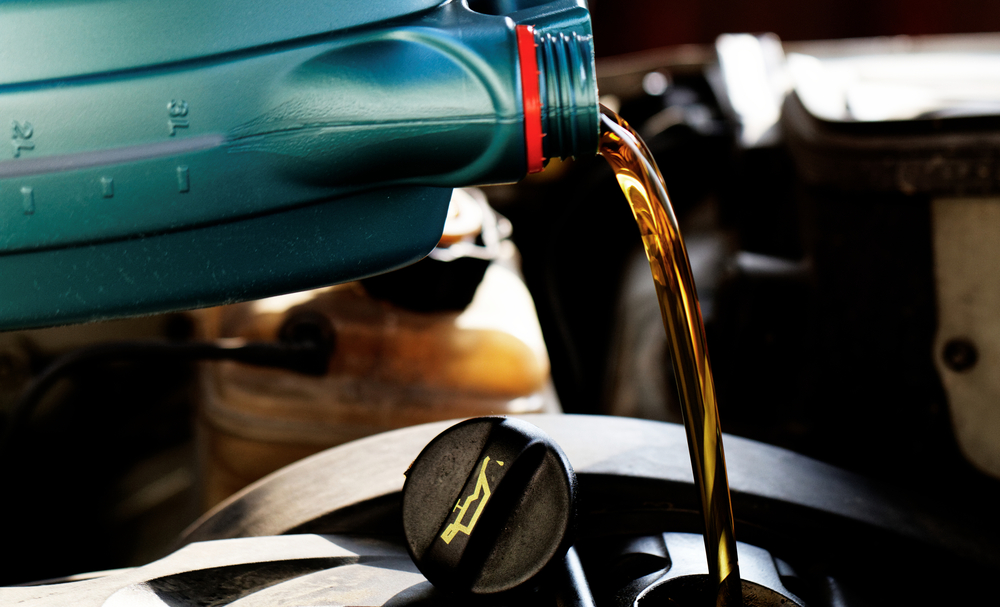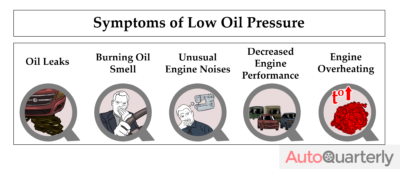A warning light on your dashboard is never a good sign, especially if it’s the low oil pressure light. Unfortunately, many people ignore this warning light as they don’t understand why it’s on or don’t know what it means.
Ignoring the low oil pressure light can result in severe consequences for your car’s engine. If your low oil pressure light is on, we’d recommend addressing the issue before it creates more serious problems. It’s usually not something that’s immediately dangerous to drive with, but ignoring the light could irreparably damage your car or lead to a very expensive mechanic’s bill.
This article covers everything you need to know about low oil pressure, including common causes and tips on preventing low oil pressure.
What Is Low Oil Pressure?
Your engine needs oil to function correctly; without oil, your engine would seize up and stop working very quickly. In addition to needing the correct amount of oil, your engine needs the right type of oil, and the oil pressure must be right.
If something isn’t quite right with your engine and the oil pressure is low, you’ll see a warning light on your dashboard. This warning light is meant to alert you to the issue so that you can turn off the engine before any serious damage occurs.
Low oil pressure is detected by the engine control unit (ECU) via an oil pressure sensor. If the sensor detects that the pressure is low, it alerts the ECU, and the warning light appears.
Why Is Low Oil Pressure Bad?
Any engine oil issues can cause massive problems, from unusual noises to decreased engine performance. In the worst-case scenario, oil problems can lead to total engine failure.
Engine oil provides lubrication to the internal components, which protects them from friction and wear. Oil also prevents corrosion and removes damaging debris from the engine.
Oil can’t get to where it needs to be if the oil pressure is low. That means some important components won’t be protected, resulting in them wearing quicker. This causes parts to seize up, and the engine can fail altogether if there’s not enough oil.
Low oil pressure is not something to be ignored. If your car’s low oil pressure light is on, you must get the problem fixed before driving any further. Failing to do so can result in your engine seizing up, which will cost you a lot of money to fix.
What Causes Low Oil Pressure?

What actually causes low oil pressure? The following three areas are the most common reasons why the low oil pressure light comes on.
1. Problems With the Engine Oil
Engine oil directly affects the oil pressure inside the engine. There are three key reasons behind this, all of which are pretty inexpensive to fix.
Low Oil Level
Low oil levels can be responsible for a low oil pressure warning light. That’s because low oil levels reduce the oil pressure, which is then detected by the oil pressure sensor.
If your oil level is low, you can simply top it up with fresh oil. Make sure you don’t overfill the oil as that can cause additional problems. There will be minimum and maximum markings on the dipstick showing you the correct level.
There’s probably an oil leak if you’re regularly topping up the oil. You can quickly check for oil leaks by looking under the car or inside the engine bay. If you need to buy oil, a bottle of synthetic engine oil will cost you around $30.
Incorrect Oil Viscosity
There are many synthetic engine oils on the market, each designed for different types of engines. The biggest thing to look out for with engine oil is its viscosity, which is how thick the oil is. Some oils are thicker or thinner at different temperatures, and using the wrong one for your engine can result in the oil pressure light coming on due to the oil being too thin.
If you’ve used the wrong oil in your car, you’ll need to drain it and refill it with the right oil. You can find the right type of oil for your vehicle by looking in the owner’s manual.
To learn more about oil viscosity, take a look at Total’s website, where they explain it in more detail.
Bad Engine Oil
Engine oil naturally degrades over time as it picks up a lot of debris and contaminants in the engine. If you haven’t changed your oil in a while, it’s worth doing. Bad oil will clog up and cause blockages, which causes oil pressure problems.
You can do an oil change yourself at home or pay a garage to do it if you’d prefer. A DIY oil change will cost you under $50, depending on the brand of oil and the type of oil filter you need. A garage may charge slightly more, but the benefit is that you won’t get dirty.
2. Worn or Faulty Components

If there are no problems with your oil, you may have worn out or faulty engine components. These components wear out over time, and can become defective due to a lack of maintenance.
Worn Engine Bearings
Main and rod engine bearings wear out over time. They’re more likely to be worn if your engine has high mileage or if it hasn’t been looked after properly. The bearings help create higher oil pressures due to their clearances. If they’re worn, the clearances are larger, allowing more oil to flow, thus reducing the oil pressure.
If your engine bearings are worn, they’ll need replacing. They’re a tough job for the DYI mechanic, but professional replacements aren’t cheap and will set you back thousands of dollars!
Faulty Oil Pump
The oil pump plays a pretty important role as it helps oil move through the whole system. If your oil pump is faulty, oil won’t get to where it should be, which can damage the engine as there’s no lubrication. This is another cause of low oil pressure.
An oil pump can fail for several reasons. It may just be old and worn out, or it may have become damaged through poor engine maintenance. If you need a new oil pump, expect to pay between $300 and $1,000 in total.
Faulty Oil Pressure Sensor
If your oil level is correct and there are no other symptoms, your engine might not actually have low oil pressure; the oil pressure sensor might be faulty. A faulty oil pressure sensor will cause the low oil pressure light to come on as the sensor provides incorrect information to the ECU.
If that’s the case, you’ll need a new oil pressure sensor. A new sensor costs around $50, with labor costing an additional $50.
3. Clogged Filters or Passages
The engine can become clogged if it hasn’t been appropriately maintained. A clogged engine results in oil not being able to move freely, which causes low oil pressure.
Clogged Oil Filter
Oil has to pass through the oil filter before it enters the engine. This is to ensure debris is filtered out and doesn’t cause damage to the engine. If the filter is clogged, it may be preventing oil from entering the engine, resulting in low oil pressure.
Oil filters are cheap and easy to replace, with a new oil filter costing less than ten bucks. We’d recommend changing the oil while you’re doing the filter, as the oil will probably be dirty.
Clogged Engine Passages
Oil is stored inside the oil sump when the engine isn’t running. When the engine is switched on, oil is pumped to the filter and then to the engine via passages. Clogged oil passages can result in low oil pressure.
You can try an engine flush to unclog the passages, although this may need to be done multiple times if the clogging is severe.
Symptoms of Low Oil Pressure
Besides the low oil pressure light, several other symptoms indicate low oil pressure. Below you’ll find five of the most common symptoms of low oil pressure.
Oil Leaks
Leaking oil means insufficient oil levels inside the engine, which translates to low oil pressure. If you spot any oil leaks in the engine bay or on the ground, get it sorted as soon as you can.
The leak may only be minor, but you’ll lose enough oil to start causing problems over time.
You can add more oil to your engine if the leak is small. However, this isn’t a permanent solution, and it won’t help if there’s a significant leak.
Burning Oil Smell
Burning smells are never a good sign, especially if it’s the smell of burning oil. The engine shouldn’t burn oil, so if you can smell burning oil, something is wrong. Burning oil indicates that oil is getting someplace it shouldn’t be, usually via a leak.
Unusual Engine Noises
A car engine should sound like a sewing machine, not a bag of bones. If you can hear unusual noises coming from your engine, something is seriously wrong, and it might be caused by the oil not getting around the engine properly.
In addition to providing lubrication, the oil helps move certain components, like the lifters. If the oil pressure is too low, they won’t move correctly, causing tapping sounds.
Decreased Engine Performance
You may notice that your engine isn’t performing as it should be, both in power output and fuel economy. Many issues can cause this, one of them being low oil pressure.
Engine Overheating
Engine oil is excellent at transferring heat away from the hot engine cylinders, helping keep the engine cool. If your engine is overheating, it could be due to low oil pressure.
That said, it’s more likely that something is wrong with the cooling system. Never allow your engine to overheat as it can warp or crack the cylinder head, which is very expensive to repair.
Preventing Low Oil Pressure in Your Engine
Prevention is better (and often cheaper) than the cure. Preventing low oil pressure from developing in the first place is better than spending a bunch of money fixing the problem, so what can you do to prevent low oil pressure issues?
Perform Regular Oil Changes
You should change your engine oil at regular intervals. Most vehicle manufacturers recommend changing the oil every 5,000 miles or every year, whichever comes first. You should also change the oil filter at the same time.
Ensure the Oil Level Is Topped Up
Make sure your engine has the right amount of oil. You can use the dipstick to check what the level is at. If it’s low, add oil until it’s at the right level.
Fix Any Leaks or Burning Smells
If you smell burning oil or notice any leaks, get them fixed ASAP. Fixing oil leaks is often cheaper than fixing low oil pressure issues, so don’t allow the problem to get worse.
Don’t Abuse Your Car
We appreciate that not everybody drives their car like they stole it, but some do. Thrashing the engine puts extra strain on components, which causes them to wear out quicker. This can cause many issues to develop, including low oil pressure problems. Take care of your car and don’t abuse it.
No Pressure

Having the low oil pressure light come on can be quite scary, especially if you don’t know what it means. If it does appear, stop your vehicle immediately. Continuing to drive your vehicle may cause irreversible damage to the engine.
Fixing a damaged engine can cost a lot of money, whereas fixing the cause of low oil pressure may be relatively cheap. You might be able to fix the problem yourself, although it will take a professional to solve the issue in some cases.



